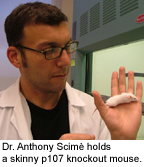Newsroom
News Releases
Ottawa scientists make mice that don't get fat
"Knockout" mice release extra calories as heat instead of storing them as fat
Ottawa, November 8, 2005"Knockout" mice release extra calories as heat instead of storing them as fat
 In a study with implications for treating obesity, a team of scientists from the University of Ottawa and the affiliated Ottawa Hospital Research Institute (OHRI) have discovered a molecular switch that regulates the creation of new fat cells. The group found that "knockout" mice that lack a gene called p107 have half as much fat as normal mice, and the fat they do have is not the conventional type. The precursor cells that normally give rise to white fat, the kind that stores fat, instead form brown fat, which is used to generate heat.
In a study with implications for treating obesity, a team of scientists from the University of Ottawa and the affiliated Ottawa Hospital Research Institute (OHRI) have discovered a molecular switch that regulates the creation of new fat cells. The group found that "knockout" mice that lack a gene called p107 have half as much fat as normal mice, and the fat they do have is not the conventional type. The precursor cells that normally give rise to white fat, the kind that stores fat, instead form brown fat, which is used to generate heat. "Brown fat is kind of like an inefficient engine," said Dr. Michael Rudnicki, Senior Scientist and Program Director of Molecular Medicine at the OHRI. "Instead of using its fuel to do work, brown fat releases it all as heat. The p107 knockout mice eat just as much as normal mice, but they burn off all the extra calories."
Humans are born with about five percent brown fat by body weight, but they lose most of this shortly after birth. Brown fat persists throughout life in many mammals, including mice, and it is especially important as a heat source for hibernating animals. It appears brown because it is has a rich blood supply and is full of iron-containing cellular energy factories called mitochondria.
p107 is a member of the Rb family of adapter proteins which couple cell cycle regulation to differentiation. Dr. Rudnicki's group has previously shown that p107 knockout mice are born the same size as normal mice, but their growth is slowed and they never quite reach full size. The current study, published in the November issue of the journal Cell Metabolism, is the first ever to link p107 to fat cell differentiation in animals. p107 appears to work through pRb to prevent the expression of a transcription factor called PGC-1alpha , which itself regulates UCP-1. UCP-1 is the protein that causes brown fat to generate heat.
Deciphering this pathway could lead to new ways to treat the growing obesity epidemic. Sixty million Americans and more than five million Canadians are considered obese. Many more are overweight.
"Drugs that inhibit p107 might be able to prevent the body from making white fat," said Dr. Anthony Scimè, a postdoctoral fellow in Dr. Rudnicki's lab and the study's lead author. "This could be a particularly effective strategy, because previous studies have shown that once white fat cells are created, they are very difficult to get rid of. Also, once brown fat is created, it would continue to burn extra calories off as heat."
Dr. Mary-Ellen Harper, an Associate Professor of Biochemistry, Microbiology and Immunology at the University of Ottawa, has studied brown fat for many years and collaborated on the current study. "These findings are exciting," she said. "They provide yet another example of the value of interdisciplinary collaboration in medical research."
Dr. Michael Rudnicki is also a Professor of Cellular and Molecular Medicine at the University of Ottawa, the Canada Research Chair in Molecular Genetics, a Howard Hughes Medical Institute International Scholar and Director of Canada's Stem Cell Network. This work was supported by grants from the Canadian Institutes of Health Research and the Canada Research Chair Program.
The OHRI is the research arm of The Ottawa Hospital and an Institute of the University of Ottawa.
Media Contact:
Jennifer Paterson
Communications Manager,
Ottawa Hospital Research Institute
613-798-5555 extension 19691
jpaterson@ohri.ca
www.ohri.ca
